Author’s note: Earlier this month, U.S. District Judge Fred Biery ruled that members of the Lipan-Apache “Hoosh Chetzel” Native American Church would be allowed space to worship at a sacred site in the headwaters of the San Antonio River within a city-owned park. However, in his preliminary ruling, he wrote that they were to be allowed access for only small groups of 20 or fewer and no more than an hour and only on “specified astronomical dates.”
He also rejected two key demands of their lawsuit: protecting the birds and the trees of the park that make up the “spiritual ecology” of the site. He has promised a longer, more complete ruling in the near future. Meanwhile, attorneys for the plaintiffs alerted the court on Oct. 25, 2023, that they plan to appeal the judgement to the Fifth Circuit Court of Appeals.
At a recent gathering for Indigenous Dignity Day days ahead of their ruling, participants in a water ceremony in the park were forced to toss their flower offerings over a city chain-link fence blocking the location in an attempt to release their prayers to the water of the river. Most flowers didn’t clear the cement banks. — Greg Harman
For most of a week in late September, attorneys gathered in a federal courthouse downtown San Antonio and debated the engineering merits of different forms of wall construction.
They struggled to untangle the migratory pulse of the double-breasted cormorant from those of egrets and herons. And they compared various accountings of trees proposed for destruction or relocation for a redevelopment project in the headwaters of the San Antonio River in Brackenridge Park.
But the core question for U.S. District Judge Fred Biery in Gary Perez & Matilde Torres vs the City of San Antonio has nothing to do with caliber inches or how much trench work would be required to restore the river wall at what is known as Lambert’s Beach, a one-time whites-only swimming hole. Rather, as plaintiff’s attorney Mark Rasmussen of the Jones Day law firm drove home during closing arguments on Friday, the matter to be decided is whether the City of San Antonio has made sufficient effort to provide members of the Lipan-Apache “Hoosh Chetzel” Native American Church access to one of their holiest sites for religious ceremony.
Para leer esta historia en español ver Lo Sagrado y la Ley en San Antonio, Texas.
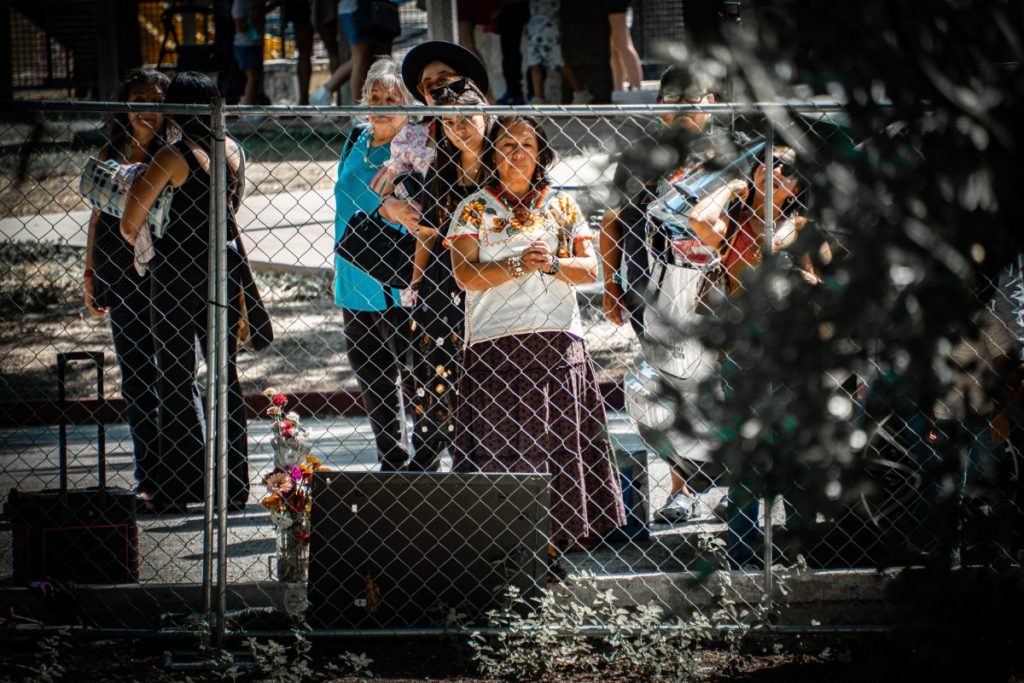
“The city is pursuing a plan that will devastate the sacred ecology of the park [and limit] future generations of indigenous and non-indigenous people’s ability to enjoy the park,” Rasmussen said. The City, he continued, has an obligation to work to meet the claims of religious liberty “but it hasn’t even tried.”
A deep and vocal resistance to the City’s plans to redevelop the upper portion of Brackenridge Park— largely with dollars secured in 2017 in a public bond vote promising generic improvements—took root in January 2022 immediately after it became public that the City planned to accomplish their goals in Brackenridge by removing more than 100 trees while forcefully evicting a rookery of migratory birds.
Central to this redevelopment project intended to “tell the story of water in San Antonio” are the crumbling hundred-year-old walls at Lambert Beach. Virtually all of the City’s arguments to date used to justify their bird and tree removal efforts within the first phase of the Brackenridge project have turned on the logic that the City’s options for repairing and restoring this short stretch of river wall are limited by the US Secretary of Interior’s guidelines for historic locations like Brackenridge. These guidelines, they say, require the walls to be rebuilt in place—and, hence, require significant construction work behind the existing walls where a number of towering oaks now stand.
But, as Rasmussen jabbed on Friday, it’s not like the City doesn’t know how to ask for exemptions to the law. In fact, the proposed tree “chop,” as it became known by the many local residents who organized loosely but steadily in opposition, turns on an exemption the City secured from local and stage regulators that otherwise would have required all of the largest “heritage” and 80 percent of so-called “significant” trees to remain undisturbed, in keeping with the City’s tree preservation ordinance.
The City staffers pursuing special permissions to remove the trees simply didn’t think pursuing a similar waiver to protect the religious rights of Gary Perez and Matilde Torres was as important as removing the trees and completing the bond project as they envisioned it, plaintiff’s attorneys charged. Perez and Torres filed their lawsuit the day after Mayor Ron Nirenberg and most of the San Antonio City Council approved the project in August.
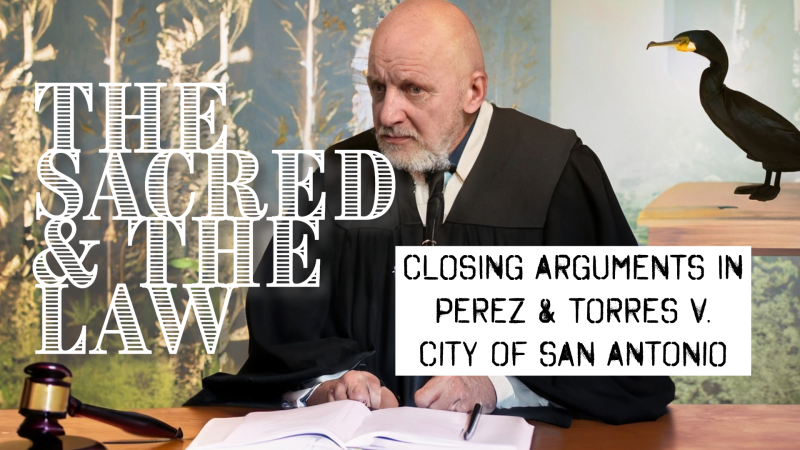
Meanwhile, the City’s attorneys, and a number of City staff who testified as witnesses in the case last week, claimed that, while they had made efforts to accommodate the plaintiffs’ claims (more about that below), ultimately what little effort they had made wasn’t actually required.
One of the defense attorneys’ few references to federal case law supporting their position drew on highly controversial judgements, such as Navajo Nation v. U.S. Forest Service, wherein the US government claimed the right to contaminate mountain peaks held sacred by the Navajo Nation and other Southwestern tribes. More on that toward close below.
Deceleration missed opening arguments on Day One, but attended the rest of the week-long trial. Below are some of the most revealing exchanges and anecdotes we expect to play a part in the ultimate decision of Judge Biery, who is likely to rule sometime within the next few weeks.
Judge Biery granted a partial order on Oct. 2 requiring the City of San Antonio to provide access to the sacred site for planned ceremonies in November and December.

The Request
The same day Perez and Torres’s legal team sued the city they also filed a request for a restraining order.
If granted, it would require the City to cease:
1) preventing Plaintiffs from holding religious ceremony at the sacred area of Brackenridge Park;
2) engaging in activities to deter the double-crested cormorant bird from nesting within the park;
3) and stop them from removing trees and other habitat from the park.
Already Perez and Torres, along with members of their ceremonial community, have been denied access to their declared sacred location within the project area on multiple occasions, their attorneys asserted.
On March 13, 2023, for instance, after losing his aunt and grand niece in an accident, Perez went to the river to pray for their travels through the underworld. He was unable to stand between the towering cypress trees on the river’s south bank, the judge was told, since the City has installed security fencing around the project area to facilitate bird and tree removal. On this occasion he did not submit a formal request. “His mind was not on what form do I need to fill out, who do I need to submit it to. He needed to go to that sacred location and mourn for his ancestors,” one of his lawyers told the judge.
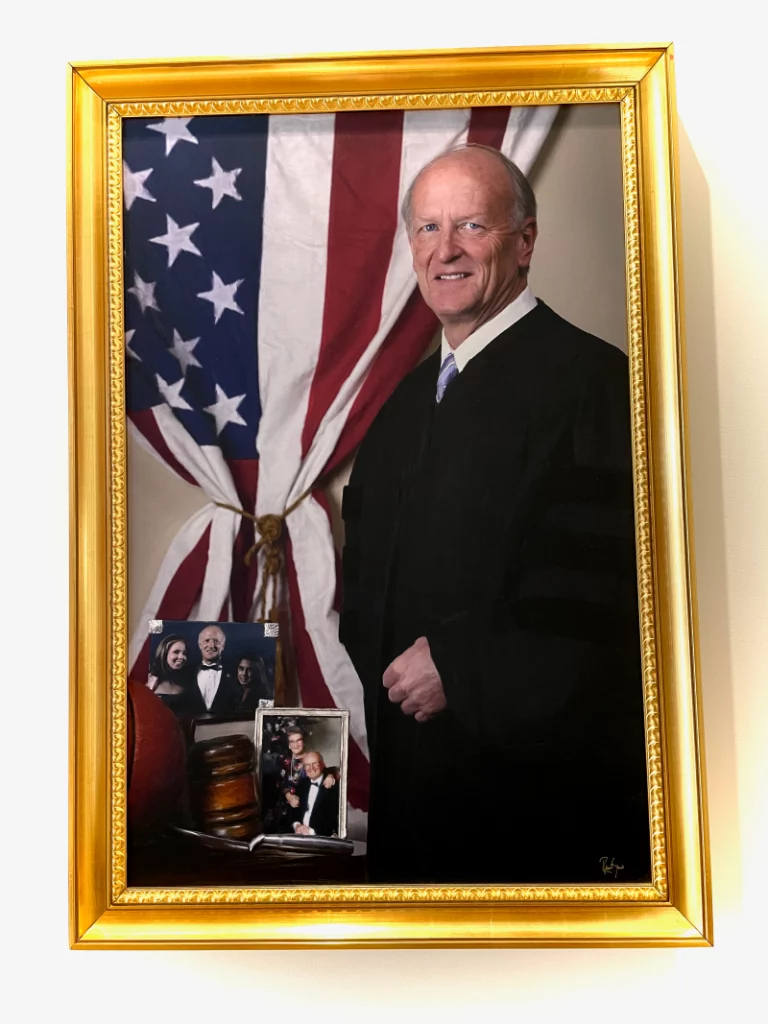
Portrait of Judge Biery hanging inside the San Antonio Federal Courthouse. Image: Greg Harman
Perez and Torres, however, formally sought access to this sacred space within the project area for ceremonies on August 12 and September 21. The City denied those requests, offering instead access to several locations outside the erected fencing erected around the project area. It was, as their attorneys pointed out, space available to anyone visiting the park and, therefore, not an actual accommodation.
Many times during the trial, defense attorneys have claimed they were unable to grant access to the sacred site due to security fencing in the area.
“I have wirecutters at home and I’ve cut through fences like that before,” Judge Biery said. “I think that problem can be solved.”
An overhanging branch described by one arborist as a “widow maker” at the site was another justification for denial of entry. However, the time needed to remove that dangerous branch was placed somewhere between 20 minutes and four hours by expert witnesses.
This sacred site is described as of the holiest locations for the Lipan-Apache Native American Church. For those standing on the south bank at this location, the bend of the river appears to mimic the coursing of the constellation Eridanus. In viewing the reflections of the trees and birds in the river from this location, ceremonial participants are able to observe a bridge between the physical and the spiritual worlds. It’s a connection that is most powerful, according to the language of the lawsuit, during the winter solstice.
The cormorant is of particular importance to the ceremonies in this space as it was a cormorant in this creation story that flew into the Blue Hole, one of the best known springs in the river’s headwaters, and was subsequently chased away by a spirit in the form of a blue panther. “As the cormorant fled from the spring, its tail feathers scattered life-giving water across the San Antonio River Valley, including the lands that comprise the Park, giving rise to life in this region,” Perez states in a declaration submitted to the court to support the request for a restraining order.
Because of this significance attorneys and witnesses discussed repeatedly whether bird deterrence efforts to drive out certain migratory birds could be modified to allow cormorants. The City’s current work order with the USDA specifically targets cattle, snowy, and great egrets, as well as cormorants, and allows a variety of tools to drive them out of city parks, including: “1. Pyrotechnic[s], propane cannon[s], 2. firearms, mylar balloons, 3. methyl anthranilate, 4. drones, lasers, effigies, scare-man, 5. nest/egg removal, 6. trucks, dogs.”
Employees working under USDA guidance agree to “prevent injury to animal life,” except, of course, for the targeted species: cattle, snowy, and great egrets and cormorants.
While numerous hearings have been held to discuss the trees of Brackenridge Park, no public hearings have been held concerning the City’s evolving rookery management plan and its bird deterrence efforts around the city, including most conspicuously in recent months in Brackenridge Park.

Objection
Perez and Torres’s lawsuit has advanced to protect the particular needs of members of the Lipan-Apache “Hoosh Chetzel” Native American Church, in the headwaters of of the San Antonio River.
The river, known by many Native Americans as Yanaguana, or roughly, “place of spirit waters,” is sacred to a variety of bands, tribes, and nations. Several of these have attempted to gain the attention of City officials and Mayor Ron Nirenberg over the past year.
The federally recognized Comanche Nation’s tribal historic preservation officer, for instance, wrote Mayor Nirenberg in March 2022. “Our Native American Church songs speak about the river of the Yanaguana and many tribes also uphold these songs today,” Martina Minthorn wrote the mayor. “We stand in support against the Brackenridge Park Tree Removal and understand the damage of the sacred trees and migratory birds.”
Tom Castillo, the chief preservation officer for the Lipan Apache Tribe of Texas, a state-recognized tribe, also wrote the City of San Antonio to object to the project as conceived.
“We feel that protecting the San Antonio River and its habitats especially the Cormorant and the heritage trees it nests in and migrates to is of utmost importance due to our ceremonious and sacred connection to them,” Castillo wrote.
“Therefore we stand with those who oppose the destruction of the heritage trees in and around the San Antonio River.”
Castillo told Deceleration in August, a year and a half after sending his letter, that no one from the City of San Antonio had responded to his letter. “[N]o one from the City of San Antonio has as of yet contacted me in regards to the letter of objection from the Lipan Apache Tribe,” Castillo wrote by email.
Deceleration was unable to reach Minthorn with the Comanche Nation as to the disposition of their complaint. Neither did Mayor Nirenberg respond to our query on the matter.
While Perez and Torres are members of the Lipan-Apache Native American Church, members of the larger Oklevueha Native American Church, with branches across North America, offered their full support for the couple’s efforts.
“We are grateful for the people who stand up to the desecration of sacred sites,” Lianne Bremer, director of communications for the Oklevueha Native American Church, wrote Deceleration.
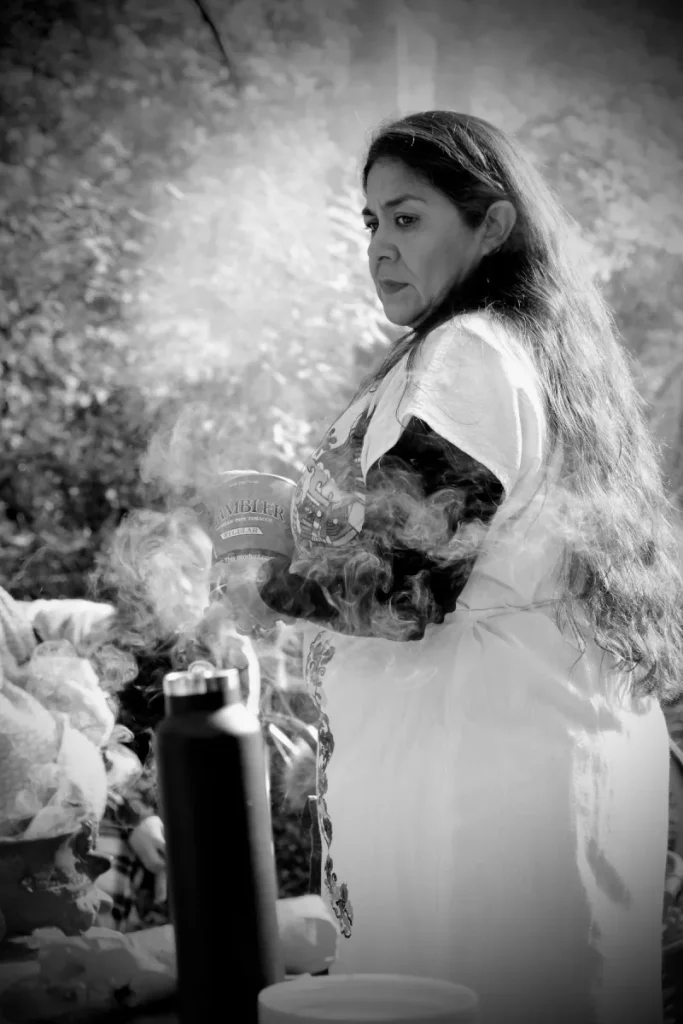
The clash of cosmovisions was clear throughout the trial, particularly in many of the references made by Judge Biery as to the commodity of trees. After all, he said at one point, the sizable trees around the courthouse did not grow in place but were trucked in to suit the construction of the building, “with large root balls,” he said, suggesting any tree removals at Brackenridge could be healed with time and good landscaping.
That attitude runs aground with Native American thought, however, as Bremer elaborated for Deceleration, stressing how trees often take on a deeper significance for Native Americans as “relatives” rather than merely a disposable resource. It is this deeper relational perspective that has informed many of the legal efforts globally for recognition of the rights of nature in the law.
“All indigenous cultures are of the earth, and honoring and respecting nature and our connection to it is the foundation of their identity,” Bremer wrote to Deceleration. “While a tree or a group of trees may just look like an obstacle to one man, to a Native American those trees are relatives.
“What is sacred to a Native American may not be understandable to other cultures and seem outdated and simplistic,” Bremer continued. “However, as with all religions and cultures, society needs to be respectful of the beliefs and customs of other peoples. Even more so with the Native Americans. This is their land. They have been required to sacrifice so much in the name of development and progress, and to what end?”
Cut it Down
Values in conflict were apparent in the judge’s comments and across the range of witness testimony.
Highlighting a small point beside the river on a map of the project area, plaintiff’s attorney Jonathan Guynn of the Jones Day law firm asked Jamaal Moreno of the City of San Antonio’s Public Works Department if Moreno knew this site was considered a “sacred area.”
“I thought it was just the project area,” said Moreno, who oversees the Brackenridge Project for the City.
Guynn then drew a line around what is understood as phase one of the Brackenridge project. This broader area is not the “sacred area,” Guynn said. Only the small red mark on the southern bank of the river, situated between two towering cypress trees, is the sacred area.
“I understand that now,” Moreno replied.
And did Moreno understand now that “excessive” tree removal outside the sacred area would “devastate” the area’s sacred ecology?
“Yes. I understand that now,” Moreno replied.
Did he understand that the “excessive removal” of trees and displacement of migratory birds would weaken what the lawsuit refers to as the space’s “spiritual ecology”?
“OK. I understand that,” Moreno said.
This new-found understanding of Perez and Torres’s claim was repeated by Assistant Parks Director Bill Pennell, who oversees the City’s bird deterrence efforts that work to prevent egrets and heron from nesting around the city. Parks Director Homer Garcia said essentially the same. Of course, Perez and Torres—and many others besides—have been telling anyone who would listen throughout the project’s year and a half of public hearings and open houses that this was sacred land.
Yet even with this suddenly clarified understanding of the parameters of the sacred, project manager Moreno’s ultimate stance did not shift.
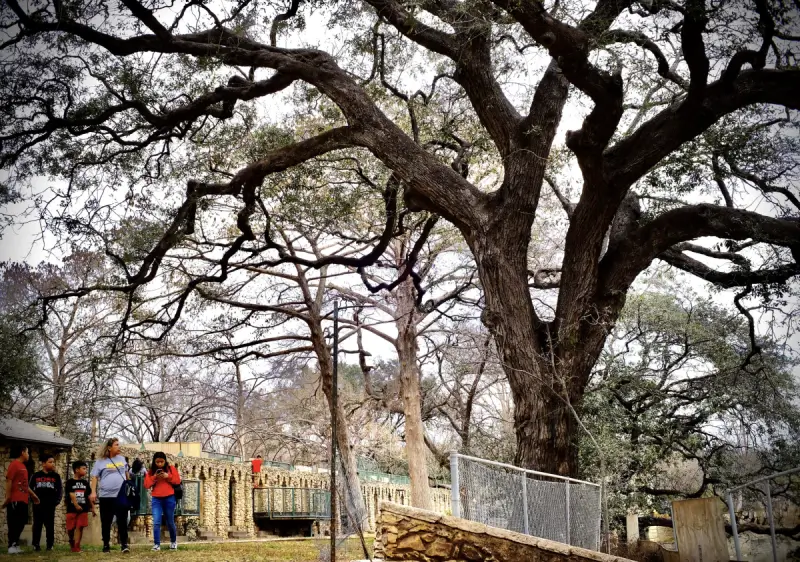
Asked if he would remove a tree with the eggs of migratory bird within, Moreno said no. That he would avoid that tree due to the protections granted by the US Migratory Bird Treaty Act. How about a tree someone claimed had significant religious value to them? he was asked. Yes, he replied. He would chop that tree down.
Moreno explained his reasoning at another point of the trial: “We didn’t want to take those steps back and start over.”
“You don’t want to step back?” a plaintiff’s attorney asked.
“It would take time and money. But we do not want to step back; no,” Moreno said.
Judge Biery and attorneys arguing the claims of the case frequently sought to analogize Perez and Torres’s claims with comparisons to Catholic beliefs. What would you do if you couldn’t attend mass at Notre Dame, Judge Biery mused. That shrine is believed to derive particular sanctity for Catholics due to alleged possession of nails that once pierced Jesus Christ, he said. Could you, like a Catholic, receive mass elsewhere? Would that mass be as good?
An attempt to respond to that comparison likened it to being required to enter a church from a “side door” and stand for ceremony “at the side of the altar.”
The tone-deaf nature of the City’s efforts concerning Native peoples was captured on The Source, a call-in show with Texas Public Radio’s David Martin Davies, when Matilde Torres dialed in to ask in February 2022 about the failure to consult with any of the area’s Indigenous Peoples who hold this location sacred.
“Knowing it is a sacred land, a sacred river, what do they plan to do? When they talk about preserving culture what exactly does that mean?” Torres said. “They have not contacted any of the indigenous groups. There’s the Lipan, there’s Tehuan Mission Indians, there’s Coahuiltecans.”
Moreno didn’t respond to the question as asked: Did the City plan to consult with Native peoples about the project. Rather, he responded that the City would reach out to those groups when it was ready to construction interpretive signage for the area. After the birds were gone, in other words, and the trees were removed.
“We want to interpret all that history and we want to put that information out there,” Moreno said. “We’re just not at the point in the design process where we have done that.”
City Manager Erik Walsh displayed a similar indifference in June of 2023. After more than a year of Indigenous claims surrounding Brackenridge calling out the City for failing to consult with Native peoples, Walsh announced that he had reconstituted an advisory committee on Brackenridge Park to guide future decision making. Only one seat among 23 on the Brackenridge Park Stakeholder Advisory Committee was reserved specifically for Native American interests.
Two of those 23 seats, by comparison, went to golf-related businesses.

On Faith
The approach of the plaintiffs and defense attorneys differed in the degree to which they cited case law.
Plaintiff’s attorneys, including a leading scholar in religious liberty claims, members of the University of Texas School of Law, UT Law and Religion Clinic, and members of the prestigious law firm Jones Day, alleged violations under the First Amendment of the U.S. Constitution, Article One of the Texas Constitution, the federal Religious Land Use and Institutionalized Persons Act, as well as the Texas Religious Freedom Restoration Act. They additionally made multiple references to case law to support their claims.
By comparison, even upon closing arguments Judge Biery had to prod the City’s attorney, Natalie Wilson of the San Antonio-based Langley & Banack law firm, to root her objections in existing case law. The citations she offered drew an audible gasp at one point from some law students in the room observing the trial. It was for good reason.
Wilson referenced Navajo Nation v. U.S. Forest Service, which hinges upon the US government’s supposed right to pollute the San Fransisco Peaks of Arizona, which reside within the Coconino National Forest and are held sacred not only by the Navajo (Diné) peoples, but also the Hopi, Havasupai, and White Mountain Apache Nation.
Meanwhile, in Lyng v. Northwest Indian Cemetery Association, another justifying decision claimed by the defense,the US Supreme Court ruled that logging roads could be constructed even though they threatened religious practice, severely eroding the rights of Native Americans.
Wilson also picked upon on Judge Biery’s habit of seeking to understand Native thought by offering seemingly equivalent Catholic rituals or beliefs. Perhaps seeking to score hometown pride points, she claimed in her closing arguments that for Catholics, at least, mass at San Antonio’s San Fernando Cathedral was as good as any other mass in any other Catholic church.
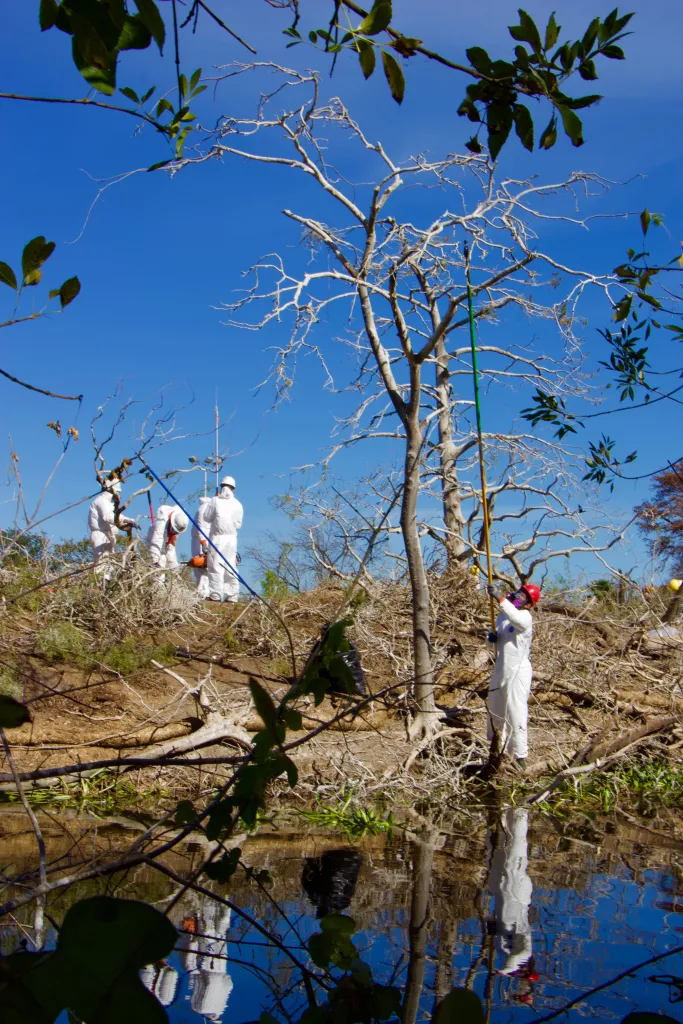
The meaning here was hard to misinterpret: Perez and Torres and others of their faith could go find another tree, another bird, another river.
Wilson, and those accepting her declaration, were embodying a continuation of past oppressions of Native peoples—in argument as well as indulgent humor.
As Joel West Williams, a citizen of the Cherokee Nation and a senior staff attorney at the Native American Rights Fund (NARF), reminds in an article co-written with Emily deLisle in Ecology Law Quarterly in 2021: “[T]he government has at times desecrated, destroyed, or barred access to sacred sites, rendering Native religious exercise extremely difficult or impossible.”
“In a nation that purports to value religious freedom, tolerance, and equality, the legal system ought to provide protection to Native American sacred sites. In practice, however, Native American religious practitioners have rarely enjoyed the judicial protection afforded to adherents of faiths more familiar to most Americans and American judges,” the pair conclude in their critique of how cases like Navajo and Lyng have been applied in recent legal decisions.
Wrapping up, the City’s Wilson quoted from the Broadway musical Hamilton to complain: “’They don’t have a plan, they just don’t like mine.’ And that’s what this case has been about for the last four days.”
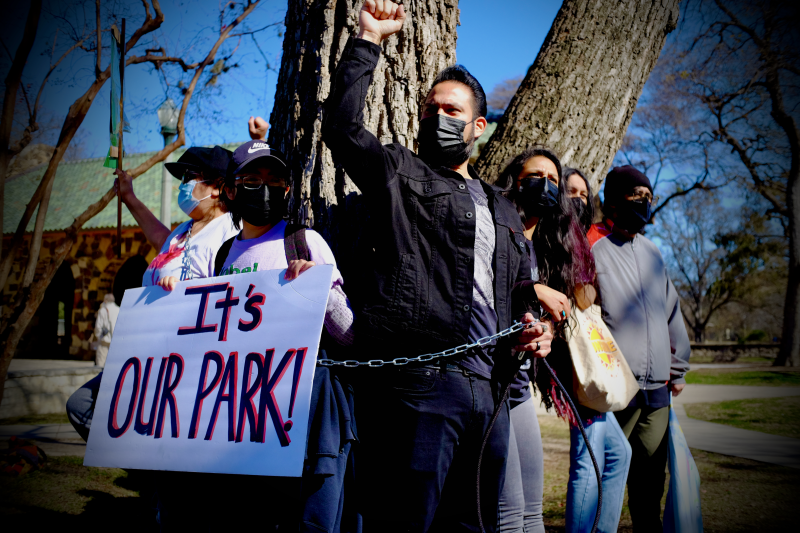
In Conclusion
Of course, those who believe their religious life is being wrongfully eroded due to governmental oppression are not required to develop alternative engineering plans, Rasmussen rebutted. They only must prove their oppression.
Though Judge Biery had already reduced the plaintiff’s counsel requested hour to make their closing arguments to 45 minutes (“I assume you all want to go home,” he said), the judge still couldn’t help interrupting.
As Rasmussen compared the City’s Brackenridge project to leveling a synagogue and “putting in an office park,” Biery interjected that, according to his understanding of the testimony of several of the City’s witnesses, no matter what was done to repair the river wall there would still be destruction and damage and a loss of trees.
“In order to save the trees, the construction would have to be scuttled—just don’t do it,” Biery said. “And even if the construction is not done and the walls deteriorate, the trees have problems. The trees might live longer but only if there is not construction.”
In his rhetorical entrenchment, Biery demonstrated he was stuck in the same spot where much of the the last year’s worth of debate over Brackenridge has floundered. How many inches of trees lost? How many planted? What was the weight of the construction equipment involved? Did the wall come before the trees? After? From within this dust devil of nearly paralyzing technical disagreement boosters would reliably claim that—therefore—the project must advance.
Isn’t it true, the judge seemed to be asking. There is no workable alternative to the project as envisioned?
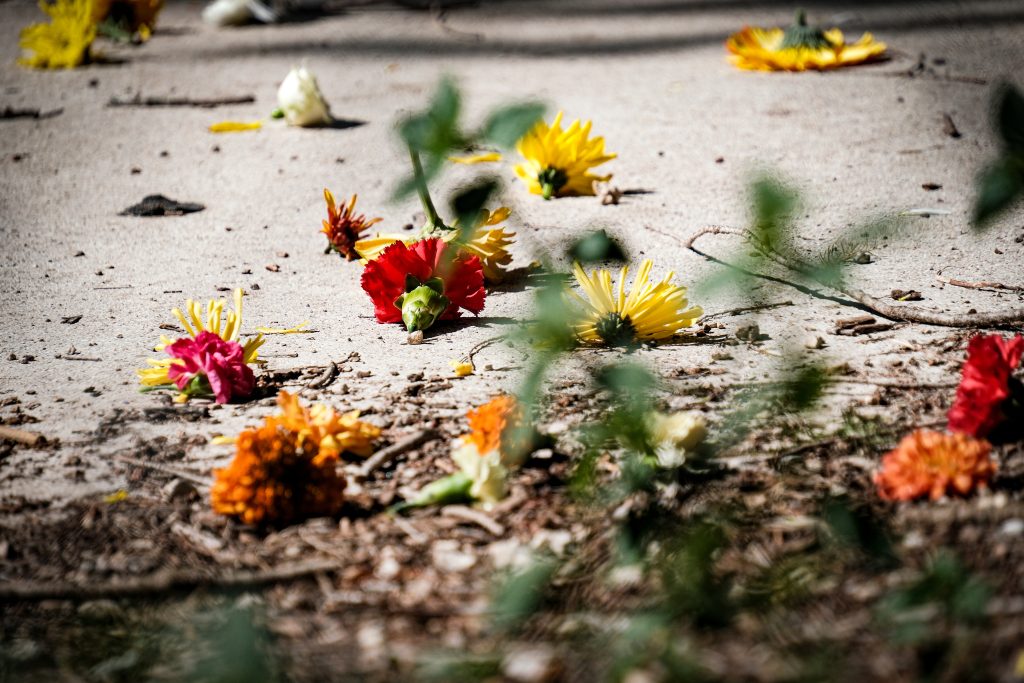
Entering first his disagreement with those logics, plaintiff’s attorney Rasmussen responded by plunging deeper into the heart of the alleged violation. Referencing a quote from the U.S. Constitution on display in Biery’s courtroom, Rasmussen mused that he had never seen a quote from the U.S. Secretary of Interior’s guidelines about historic structures hanging in any federal court. The reason for that, he continued, was because those guidelines are subservient to the U.S. Constitution. And they are subservient to the right of all people to religious liberty.
“The Secretary of Interior’s guidelines are not mandatory,” Rasmussen reminded. “The City can seek exceptions to it and they have not even tried.”
He continued: “What if we called Secretary Haaland and said: ‘We have your guidelines and we have the Bill of Rights and they seem to be in conflict. I can only imagine that she would say, ‘Follow the Bill of Rights.’”
In the coming days, Biery will issue his decision. As written responses to closing statements aren’t due before Friday, October 6, 2023, it likely won’t be before next week. In his variety of queries and statements, Biery showed he was engaging in the debate and also being moved by it.
Showing his anti-regulatory bias, he at one point said: “It’s amazing that anything ever gets done, due to all the regulations. … We’ve become like a battleship covered in barnacles.”
Yet he also appeared moved by the arguments of the plaintiff’s attorneys, asking the defense at one point what the City would do if he ruled against them.
Few appeared impressed by Wilson’s referencing of Navajo. For starters, the Brackenridge case does not involve federal land. Texas law concerning religious liberty is more stringent than the federal government’s. In addition, the Ninth Circuit Court of Appeals revisited the Navajo case specifically and reversed it in light of passage of the federal Religious Freedom Restoration Act of 1993.
John Greil, a clinical professor in the UT Law and Religion Clinic assisting in the Perez and Torres case, responded to Deceleration via email to say that neither Navajo nor Lyng apply in this case.
“We don’t believe the reasoning applies, because Lyng was about how the government conducts its internal affairs (the case was about logging on federal lands), and this issue is about a public park project that’s meant to be for the benefit of all San Antonians.” Greil said.
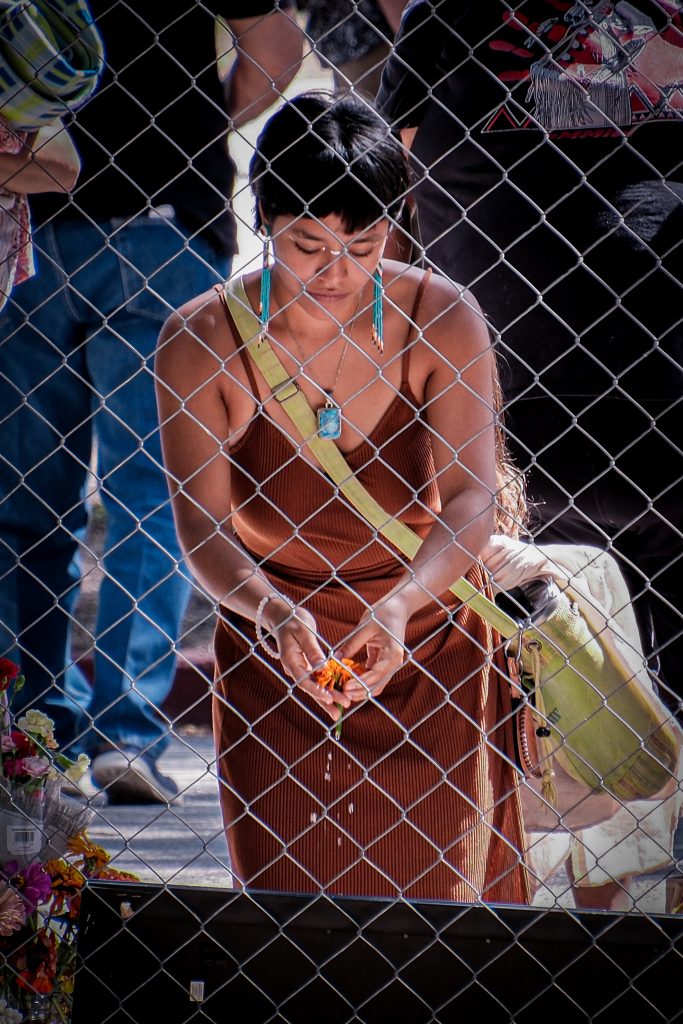
“Our case is different because it’s possible for both sides to get what they want: We say it is fine for the City to repair the Lambert Beach walls, but we believe there is a way they can do it that will not permanently desecrate this unique and sacred location.”
The way forward is to appeal to Secretary of Interior Deb Haaland, who, as Judge Biery himself reminded the room, is the nation’s first Native American head of the powerful department. She is a member of the Pueblo of Laguna and, according to her bio page, a “35th generation New Mexican.”
An appeal to Haaland appears to be one possible result that may follow with a ruling in favor of the plaintiffs. And that could lead to a very different approach to construction and bird deterrence in Brackenridge.
This story was originally published on Deceleration.news and is reposted here with permission.
La diversidad de culturas en el mundo, tenemos nuestra propia cosmovisión, nuestro territorio es multidemensional y multiverso, así mismo tenemos nuestra propia biodiversidad, las mismas tienen derecho, respeto y son nuestros hermanos/as; también tenemos en el territorio, sitios sagrados, ecológicos y arqueológicos; esta realidad y diversidad, a pesar que en la constitución dice preservar pero hay muchas autoridades que desconocen la importancia del territorio de las culturas
Es muy cierto y nos da mucho gusto saber de usted, Nicolás. Esto es cierto tanto para los lipan apaches de Estados Unidos como para los kañaris de Ecuador. Y a muchos en el Norte les sorprende que nuestros compañeros en el Sur hayan logrado muchos avances en cuanto al conocimiento y respeto a la santidad de la Tierra. Viva el Ecuador, Viva los Derechos de la Pachamama y su gente. ¡Seguimos en contacto!
Estamos interesados en ponernos contactos con alguna autoridad del Proyecto Esperanza, para hacer conocer quienes somos, que hacemos, cual son nuestras proyecciones; ademas estamos con una tarea grande para marzo o junio de 2025 la organización y ejecución del IX Congreso Mundial de la Quinua y otros granos
Hola Nicolas, yo soy la directora del Proyecto Esperanza, y ya sé algo de su trabajo y trayectoria, ya que su gran amigo Alan Adams ya escribió un artículo sobre su organización hace unos años. Me encantaría actualizarnos y escuchar lo que tienen planeados para el futuro. Escribeme cuando quiera al [email protected]. En solidaridad, Tracy